Ultrabook Head to Head: Acer Aspire S3 vs. ASUS UX31E
by Jarred Walton & Manveer Wasson on December 21, 2011 5:40 AM ESTAnd Then We Get to the LCDs…
Sadly, as much as some areas of the laptops are improved over other offerings, the displays in general are nothing to get excited about. The Acer LCD is a bog standard model while the ASUS goes for a higher HD+ resolution and one of the brightest backlights we’ve tested on a laptop; unfortunately, contrast ratio along with color quality and gamut are all in the dumps. Let’s not dwell on it too much before we see the charts.
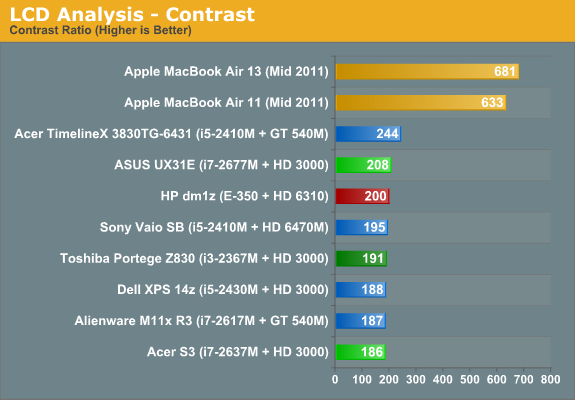
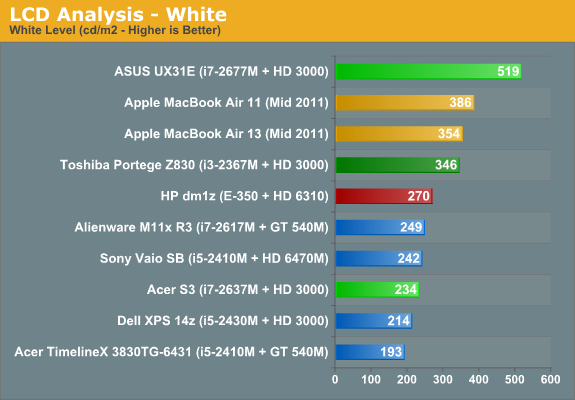
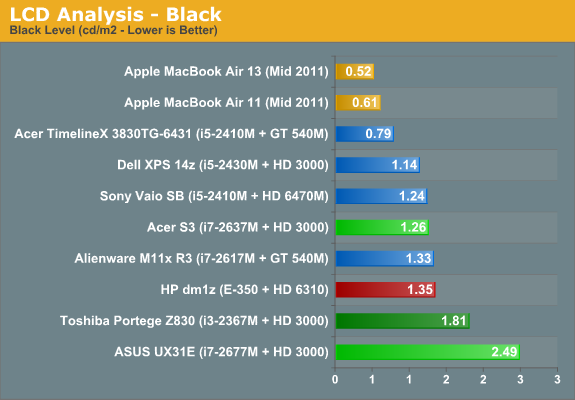
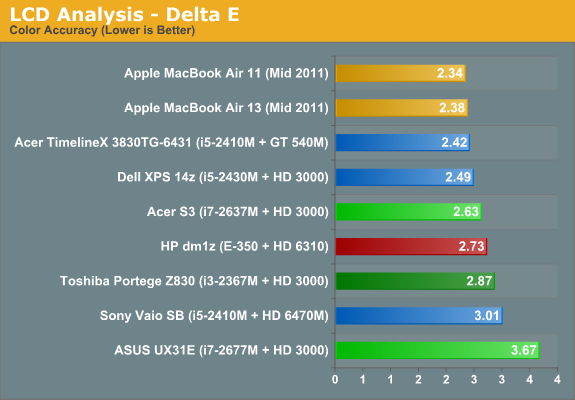
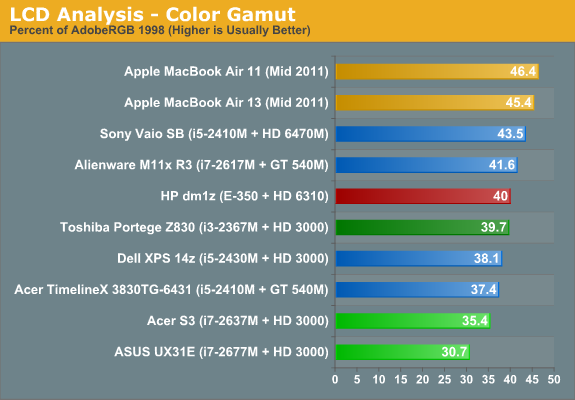
Of the laptops we’ve reviewed recently, the UX31E has the brightest LCD by far…along with the highest black level by far. The result is a contrast ratio that places near the top of our selection of eight mediocre displays. The Acer S3 on the other hand has middling white and black levels but the lowest contrast of the eight tested laptops. Continue on to color accuracy and gamut and things go from middling to lousy. The ASUS’ incredibly bright backlight results in very poor post-calibration Delta E of 3.67, with some colors in the double digits. Turn to the color gamut and we find part of the reason for that: the gamuts of both these ultrabooks are very poor, which means several of the test color patches are outside of their color range.
Viewing angles are typical of TN panels, with the vertical shots showing major color shifts. The ASUS panel does a lot better than the Acer, though neither one is great. We’ve got excellent 10.1” IPS panels now shipping in $400 tablets; why can’t we get a similar panel in 13.3” trim in a $1200 laptop? I’m probably preaching to the choir, but seriously: first IPS panel in a 13.3” laptop for under $1000 gets an Editor’s Choice award (as long as the rest of the laptop doesn’t completely suck).
In the grand scheme of things, though, how much do the LCD test results really matter? That’s a more difficult question to answer. Some users will never know what they’re missing, while others like to edit photos or watch movies and will immediately notice the poor contrast and colors. The color quality is a potential deal breaker for me, but if you’re just surfing the web and working in office applications, it really doesn’t make that much of a difference. For a go-anywhere laptop, the ASUS’ ultra bright LCD is definitely a plus—I took it outside and maxed out the backlight intensity and was still able to view the display contents without complaint, which is more than I can say for the laptops that max out at 200-250 nits.
When we look at the target the ultrabooks are trying to take down—Apple’s MacBook Air—the LCD results in particular are unacceptable. The MacBook Air displays are by no means perfect (I'd like a color gamut of at least 70% AdobeRGB for example), but notice how out of the tested laptops they place at the top in every test other than maximum brightness? That's what we'd like to see from the competition. ASUS at least made some effort to be different by going with a 1600x900 LCD with a high maximum backlight intensity, but Acer could have literally picked up any other 13.3” LCD and put in a similar showing. Take the price and OS out of the equation and the MacBook Airs are the superior “ultrabooks”, for two reasons: build quality and display quality. Acer improved their build quality over most of their budget offerings, and ASUS is right there with Apple in terms of build quality, but >500:1 contrast with >350 nits maximum brightness is the minimum I’d like to see, and really we’re talking about $1000+ laptops so it’s not too much to ask for an extra $50 to improve the displays.






















81 Comments
View All Comments
twotwotwo - Wednesday, December 21, 2011 - link
I had the same experience with the Eee Pad Transformer dock. I was surprised, because it looked a lot like the Eee 10" netbook keyboard, whose keys take very little pressure (in fact, between the small size and the light touch, you tend to get extra keystrokes on the netbook). I half suspect ASUS of angling for reviewer points for "feeling solid" when they made their more recent keyboards only work if you smack the keys. :)(I think ASUS did great overall. Software updates came out quickly, docking's nice, good price, etc., etc. But those keys: not so great.)
So--dear ASUS, premium means never having to smack the keyboard to type. Best wishes, two AnandTech commenters.
snuuggles - Thursday, December 22, 2011 - link
I suspect I am the (or one of the) people Jarred mentioned having returned my UX31 because of the keyboard. I had exactly the same issue you are having, and it was basically unusable to me--I simply couldn't do my work on the machine!Quick question, I found that pressing the bottom left corner of the enter key didn't register. This was repeatable and not because I was hitting it "too quickly", I could press the key all the way down and hold it with no response... can you replicate this? I'm guessing that this type of issue could become less and less of an issue as the keys "loosen up", but who knows, it could become *more* frequent!
I gave Jarred a hard time about recommending the UX31 in the holiday special, I was a little harsh, but I think my criticism stands: this is a mechanically flawed keyboard, and I'm not really sure how you can "look past" this issue and recommend it based on all it's other (great) features.
JarredWalton - Friday, December 23, 2011 - link
If I push on the very corner of the enter (and I mean the *very* corner), it won't register, but even an eighth of an inch in and it works fine. I will agree that the keyboard requires a bit more of a firm touch than on other laptops I've used, but it didn't bother me much. The Acer keyboard behaved similarly in my experience -- if you're a light typist, you'll miss key presses on occasion with either one. I'm sure other people will be fine with it, and some will probably even like it -- we've had people say they like Acer's floating island keys for example. I've seen the UX31E at Best Buy, so if you're picky about keyboards but are still considering the Zenbook, see if you can find some local store where you can try one out in person. Of course, that's my advice on most laptops if you're a discerning users. :-)twotwotwo - Saturday, December 24, 2011 - link
I forget that grown-ups might be reading while I snark. :) For the record, if the UX31's KB is like the original Transformer's, I wouldn't actually recommend someone avoid it just 'cause of that. Yes, checking seems reasonable.Toughbook - Wednesday, December 21, 2011 - link
It's about time someone started to offer some brighter displays. In this day and time of technology it baffles me as too why they are all stuck on the 200-250 NIT rating. I am so spoiled by my 1100 NIT display that when I have to do some work on a 200 NIT machine I feel like I can hardly see it. Being able to have a port replicator would be nice a well on these. Another feature I use almost daily. Drop it in and your done.With all that being said... We still must remember what these machines are designed for. Ultra portability. It's like wanting more leg room or trunk space in a 2 seat sports car. Something has got to give.
I can't seem to under stand what Jarred means by the Windows sticker on the power brick? I'm am totally missing something here....
Great review Jarred, keep up the good work.
JarredWalton - Friday, December 23, 2011 - link
The power brick has the Windows Certificate of Authenticity (with the license key) on it. Usually those are on the bottom of the laptop or under the battery; obviously the latter isn't an option, but moving it onto the power brick doesn't really make a lot of sense to me.geotwn - Wednesday, December 21, 2011 - link
Reading Anandtech for years I wonder why the Thinkpad X220 review is missing for long time. IMHO the IPS models beat all of the light-weight notebook hand down in terms of screen quality - it ought to be the standard to compete against if we are serious about display, but it does not get reviewed or even mentioned.JarredWalton - Thursday, December 22, 2011 - link
Because Lenovo won't send us one; it's as simple as that.twotwotwo - Wednesday, December 21, 2011 - link
Via Gizmodo, I saw a detailed tablet display comparison today (search for "Tablet Display Technology Shoot-Out" to find two different comparisons). They argue the raw contrast ratio is "Only relevant for low ambient light, which is seldom the case for mobile devices," and they measure the intensity of mirror-like and other reflections from the screen. Only the Galaxy Tab, iPad 2 and (to my surprise) Nook Tablet came out under 11% mirror reflections.I knew something bugged me about raw contrast numbers and this is it: backlight bleed is often less of a problem than reflections. Would be interesting to see, if not a detailed mirror-reflection test like that site does, at least contrast measurements that factor in reflections under whatever "indoor" and "outdoor" ambient-light levels you define.
Know lots of work goes into the measurements and it's not easy to just throw another figure in. Does seem like factoring in how much reflection you'll be seeing could potentially lead to more useful numbers.
JarredWalton - Thursday, December 22, 2011 - link
This is why I point out the high maximum brightness of the ASUS -- that makes up for most reflections (unless you're looking at a dark scene/image/movie). Of course, in direct sunlight it's probably still not enough (I'd say 1200 nits would be needed for such use), but it's brighter and more usable outside than 99% of laptops.